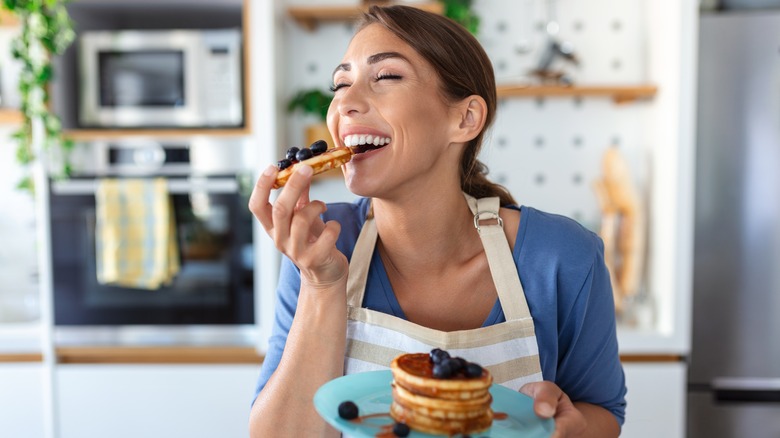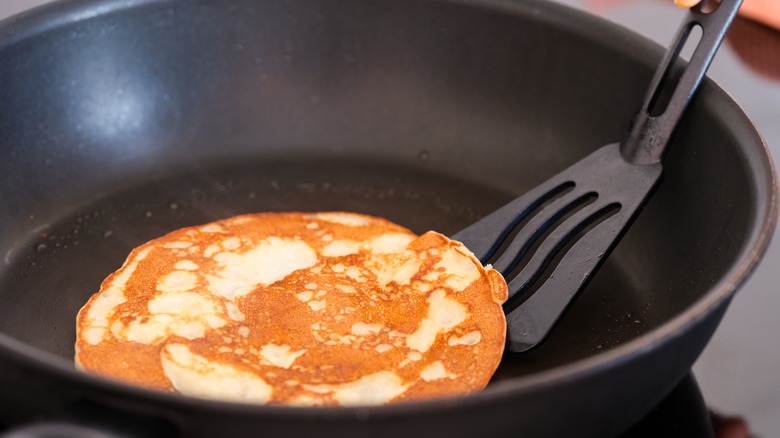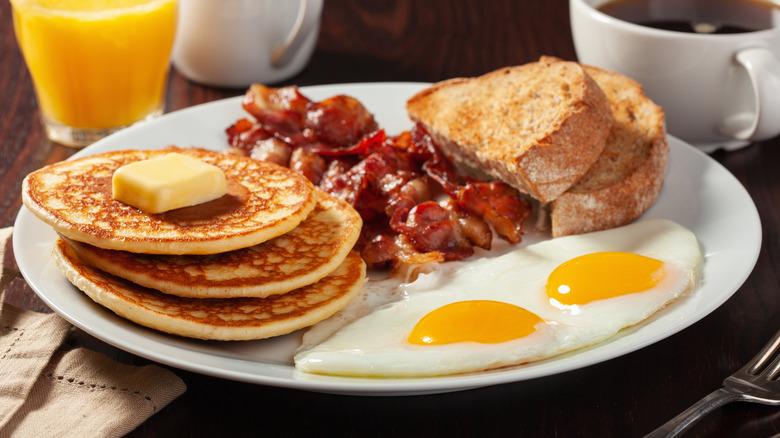The Simple Water Test You Should Never Skip Before Making Pancakes
Who doesn't love pancakes? They're buttery, fluffy, fillable with anything from blueberries to chocolate chips, and are a welcome breakfast any day of the week. This, of course, assumes said pancakes are prepared the right way. When you think of pancakes, you think of golden-brown flapjacks dripping with butter and maple syrup, not burnt blackened discs or undercooked cakes that are still raw on the inside.
While cooking pancakes isn't too hard, since all you really need is a good arm and decent motor skills to flip them, there are many pitfalls that can stand between you and a delicious Saturday pancake breakfast. If your pancake is raw and dripping with undercooked batter on the inside, it may be because your batter is too thick and your temperature is too low to cook them all the way through. If your pancakes come out dense and chewy rather than soft and fluffy, the problem may be that you accidentally overmixed the pancake batter, which results in the development of gluten. The art of making pancakes requires careful attention, the knowledge of when to mix (and not to mix), and even how thick or thin to make your batter.
But what exactly is this "water test"? How can water help you make a better pancake? In short, this simple test will help you to know just when it's the right time to put your pancakes on the griddle.
A drop of water will tell you when your pan's hot enough
How is a pancake like a steak? Is it because both of them have to be flipped? Is it that both of these items can be enjoyed for breakfast? While these are all good answers, the true answer is that both pancakes and steaks require a very hot skillet or pan to cook on, rather than being "warmed up" on a cold metal surface.
The water test involves taking a few drops of water and splashing it into a pan as it sits on the burner. This is easily achievable by running your fingers under the sink and sprinkling water over the surface of the pan. If the water doesn't do anything, this obviously means the surface of the skillet or pan is still cold. If the water begins to steam, the surface is beginning to grow warmer. If the water droplets sizzle as soon as they hit the surface, that's the go-ahead to add your pancake batter.
What would happen if you poured your batter onto a skillet or pan that was still cold? As the surface would heat up, the underside of the pancake would get more exposure to the heat over time. When you're finally able to flip the pancake, that particular side's almost overcooked. By pouring your batter onto an already hot surface, the pancake will begin to cook immediately, meaning there's less of a chance that you'll end up burning your pancake.
What is the best temperature to cook pancakes?
If the best moment to pour pancake batter on a pan is when it's ripping hot, what is the best temperature to aim for? Is there an exact specification or degree that you should look for when you're making pancakes?
Some believe that, if you're preparing your pancakes on a gas-powered stove or griddle, the best temperature to aim for is 375 degrees Fahrenheit. This is said to be the perfect middle ground, being hot enough to cook the inside and outside of your pancake at once, but not hot enough to burn the outside while leaving the inside undercooked.
At this correct temperature, all you would have to worry about then is knowing when to flip the pancake. While you may think that it's time to flip your pancake when it begins to bubble, you should wait for those same bubbles to burst, leaving the surface of the pancake dotted with holes, similar to that of a sponge. Once your pancakes have "burst their bubble," then it's the right time to flip.
While all of this may seem complicated for something as simple as a pancake, it actually becomes much easier the more you practice. Soon enough, you'll be flipping golden-brown flapjacks like it's no one's business.


